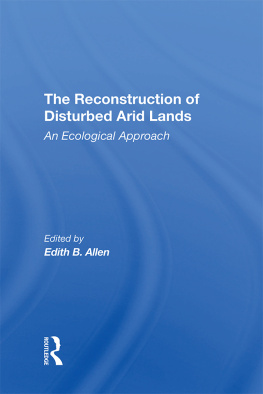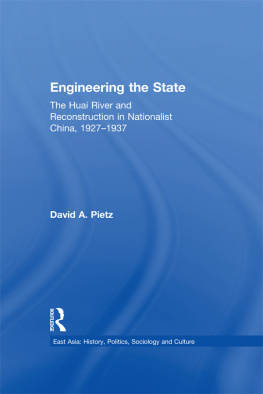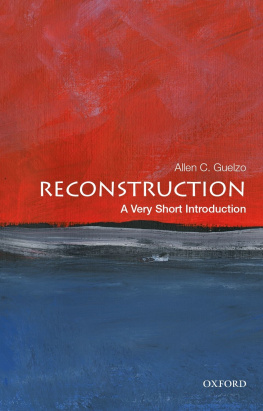The Reconstruction of Disturbed Arid Lands
AAAS Selected Symposia Series
The Reconstruction of Disturbed Arid Lands
An Ecological Approach
Edited by Edith B. Allen
First published 1988 by Westview Press
Published 2019 by Routledge
52 Vanderbilt Avenue, New York, NY 10017
2 Park Square, Milton Park, Abingdon, Oxon OX14 4RN
Routledge is an imprint of the Taylor & Francis Group, an informa business
Copyright 1988 by the American Association for the Advancement of Science
All rights reserved. No part of this book may be reprinted or reproduced or utilised in any form or by any electronic, mechanical, or other means, now known or hereafter invented, including photocopying and recording, or in any information storage or retrieval system, without permission in writing from the publishers.
Notice:
Product or corporate names may be trademarks or registered trademarks, and are used only for identification and explanation without intent to infringe.
Library of Congress Cataloging-in-Publication Data
The Reconstruction of disturbed arid lands: an ecological approach/edited by Edith B. Allen.
p. cm. -- (AAAS selected symposium; #109)
Includes bibliographies.
ISBN 0-8133-7716-1
1. Reclamation of land. 2. Arid regions ecology.
3. Revegetation. I. Allen, Edith B. II. Series: AAAS selected symposium; 109.
S613.R42 1988 88-28687
631.6'4--dc19 CIP
ISBN 13: 978-0-367-29546-2 (hbk)
About the Series
The AAAS Selected Symposia Series was begun in 1977 to provide a means for more permanently recording and more widely disseminating some of the valuable material that is discussed at the AAAS Annual National Meetings. The volumes in this series are based on symposia held at the Meetings that address topics of current and continuing significance, both within and among the sciences, and in the areas in which science and technology have an impact on public policy. The series format is designed to provide for rapid dissemination of information, so the papers are reproduced directly from camera-ready copy. The papers published in the series are organized and edited by the symposium organizers, who then become the editors of the various volumes. Most papers published in the series are original contributions that have not been previously published, although in some cases additional papers from other sources have been added by an editor to provide a more comprehensive view of a particular topic. Symposia may be reports of new research or reviews of established work, particularly work of an interdisciplinary nature, since the AAAS Annual Meetings typically embrace the full range of the sciences and their societal implications.
ARTHUR HERSCHMAN
Head, Meetings and Publications
American Association for the
Advancement of Science
This volume contains the proceedings of a symposium sponsored by the American Association for the Advancement of Science in May 1986, plus some invited chapter contributors. I thank the Institute for Land Rehabilitation, Utah State University, Logan, and the AAAS for their financial support of the international contributors. The Department of Range Science, Utah State University, provided support in the preparation of this volume, and special thanks go to Roma Henderson for her time and patience. Chapters in this volume were externally reviewed, and I thank the reviewers for their useful suggestions.
Edith B. Allen
Edith B. Allen
The desertification of arid and semi-arid lands is proceeding at a rapid rate worldwide. Over 9 million km2 are severely disturbed by soil erosion and salinization (Dregne 1983), and are in need of reconstruction to return them to their former or some other useful state. Most of the attempts to reconstruct these lands are based on agronomic, rather than ecological, concepts to reintroduce native or other non-crop species. An agronomic approach is appropriate for high-yield crop or pasture lands, but where the goal is to establish a stable, self-sustaining ecosystem that requires minimal additional resources from man, an ecological approach is needed. For example, seeding or planting in rows, fertilization, and irrigation are currently practiced to reestablish native ecosystems, but these practices bear little relationship to natural processes of establishment, are expensive to maintain, and can be inhibitory to successful establishment of desirable arid plants. Each of the chapters in this volume emphasizes an understanding and application of the basic ecological relationships among plants, animals, microorganisms, the physical environment and man to reconstruct useful, primarily wildland ecosystems.
Several terms are used to describe the return of disturbed lands to a useful state. Three of them, restoration, reclamation, and rehabilitation, were defined by a National Academy of Sciences committee concerned with surface coal mining in the western United States (NAS 1974). According to the committee, restoration implies that the exact conditions before mining will be replicated afterwards. Reclamation was defined to mean that the site will be similar in ecological functioning after disturbance, and will be habitable for similar but not necessarily the same organisms. Rehabilitation means that the land will be made useful, but with a different land use and usually different species. Since all three revegetation goals, especially the former two, are represented in this book, clearly none of these three terms alone would be appropriate. Reconstruction is used as a compromise term; the dictionary definition is to build an image of what something was in its original form. Thus it covers most of the efforts described in the chapters of this volume.
The range of precipitation zones covered in this volume is actually broader than the ecological definition of aridity. Arid and semi-arid lands are of primary concern, but two of the chapters discuss subhumid lands, one including open Eucalyptus forest (chapter by Bell) and one on tall grass prairie (Burton et al.). Since periodic drought is a problem in plant establishment in subhumid lands, these chapters are relevant to true arid lands. Hyperarid environments are not included here because their productivity is so low that they are seldom subject to disturbance by man (Dregne 1983). Because of low post-reconstruction economic returns, most reconstruction is limited to semiarid or moister ecosystems (e.g., Naveh and Lieberman 1984). Exceptions to this are on arid mined lands where revenues generated from the mineral extracted are mandated for the cost of reconstruction (chapters by Depuit and Redente, Whitford), and on sites where natural or man-induced water harvesting occurs for increased productivity (Yair and Shachak 1982). An ecological approach that enhances the processes of natural succession may also make reconstruction of more arid lands economically feasible.
This volume examines a variety of disturbances, Agriculture and domestic grazing are by far the greatest causes of desertification, and are the subject for reconstruction in the chapters by Burton et al., Naveh, E, Allen, Whitford, and Greenwood. Fire is treated as a disturbance primarily in the chapter by Oechel. Mining figures importantly in four of the chapters (Bell, Depuit and Redente, E. Allen, M. Allen) even though the land area disturbed by mining is minuscule compared to the worldwide problem of desertification. For instance, some 930,000 ha have been surface mined for coal in the United States (U.S.DOE 1984). However, mining is often a more severe disturbance than others. It has received much public attention and, in response to public pressure, is subject to reclamation laws in many nations. The importance of mining disturbances is thus not related to the land area disturbed, but rather to the amount of funded research and the number of hectares that consequently have been reclaimed. These efforts represent a unique ecological data base to be used to reconstruct many other kinds of arid and semiarid disturbances.












